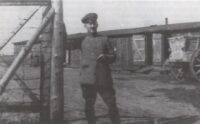There were two types of prisoners present in the area during the construction of SicherungsstelSecurity Position North.
The was the prisoners of war, primerily Russians, who in full accord with the international conventions, not was engaged in the establishment of the military installation, but in planting, drainage and similar civil works. A great deal were entrusted to the small communities, to replace the men who was sent to the front.
Some prisoners of war who was sent to the small communities stayed in Denmark after the war.
At Lögumkloster there is a cemetary for one og the POW camps.
The cemetery was built in 1915 by the German authorities for prisoners of war, who, during the First World War 1914-18, were housed in a camp at Lögumkloster under miserable conditions. In the cemetery are 71 French, Belgian and Russian victims of a typhoid epidemic in 1915.
There are many indications that the prisoners of war had significantly better terms than the German military prisoners, and there are not many graves after the POW’s.
The other type of prisoners were the German military prisoners. It was deserters and people who had committed something criminal while they were the army. The Military prisoners lived in prison camps. We know of 15 camps. Each camp was led by a Lieutenant, and the camp contained 1 or more penal companies with 250 men in each.
Rather remarkable, that Germany didn’t execute deserters, but put them to hard labour. England, and specially France, had a long list of executions.
These military prisoners were building the stronghold under inhumane conditions.
Without machines everything was done by hand and the death toll among these prisoners was very high. Either because of illness or because of escape attempts from the nasty conditions. Early up, on foot to the workplace, a day of hard work on small rations of thin cabbage soup. Then on foot to the camp late at night.
There has undoubtedly been a high death toll among the military prisoners. They worked inhumanly hard
and there have been some epidemics among them. Finally, someone has probably also been killed trying to escape.
At the northeastern part of the cemetery of Løgumkloster church, 39 military prisoners from the camp at Øbjerg are buried. These, together with the camp doctor, became victims of the typhoid epidemic that also ravaged the prisoners of war. Today, the grave is regrettably looped.
An example of the hard work was the transportation of water for molding the batteries. It was up to 1 km. to the nearest water, and it had to be carried with buckets and yokes at an even pace, so that no casting shells appeared during the casting.
Constantly under the supervision of guards with planted bayonets.
There are some reports that the slightest bit of wavering resulted in blows or a bayonet socket.


